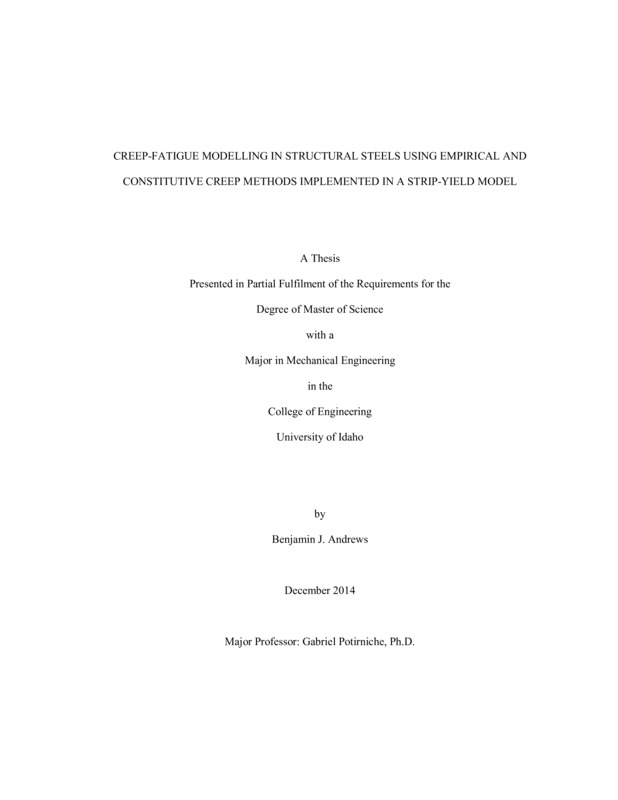CREEP-FATIGUE MODELLING IN STRUCTURAL STEELS USING EMPIRICAL AND CONSTITUTIVE CREEP METHODS IMPLEMENTED IN A STRIP-YIELD MODEL
Andrews, Benjamin. (2014). CREEP-FATIGUE MODELLING IN STRUCTURAL STEELS USING EMPIRICAL AND CONSTITUTIVE CREEP METHODS IMPLEMENTED IN A STRIP-YIELD MODEL. Theses and Dissertations Collection, University of Idaho Library Digital Collections. https://www.lib.uidaho.edu/digital/etd/items/andrews_idaho_0089n_10465.html
- Title:
- CREEP-FATIGUE MODELLING IN STRUCTURAL STEELS USING EMPIRICAL AND CONSTITUTIVE CREEP METHODS IMPLEMENTED IN A STRIP-YIELD MODEL
- Author:
- Andrews, Benjamin
- Date:
- 2014
- Keywords:
- constitutive creep creep-fatigue strip-yield model
- Program:
- Mechanical Engineering
- Subject Category:
- Mechanical engineering
- Abstract:
-
The phenomena of creep and fatigue have each been thoroughly studied. More recently, attempts have been made to predict the damage evolution in engineering materials due to combined creep and fatigue loading, but these formulations have been strictly empirical and have not been used successfully outside of a narrow set of conditions. This work proposes a new creep-fatigue crack growth model based on constitutive creep equations (adjusted to experimental data) and Paris law fatigue crack growth. Predictions from this model are compared to experimental data in two steels: modified 9Cr-1Mo steel and AISI 316L stainless steel.
Modified 9Cr-1Mo steel is a high-strength steel used in the construction of pressure vessels and piping for nuclear and conventional power plants, especially for high temperature applications. Creep-fatigue and pure creep experimental data from the literature are compared to model predictions, and they show good agreement.
Material constants for the constitutive creep model are obtained for AISI 316L stainless steel, an alloy steel widely used for temperature and corrosion resistance for such components as exhaust manifolds, furnace parts, heat exchangers and jet engine parts. Model predictions are compared to pure creep experimental data, with satisfactory results.
Assumptions and constraints inherent in the implementation of the present model are examined. They include: spatial discretization, similitude, plane stress constraint and linear elasticity. It is shown that the implementation of the present model had a non-trivial impact on the model solutions in 316L stainless steel, especially the spatial discretization.
Based on these studies, the following conclusions are drawn:
1. The constitutive creep model consistently performs better than the Nikbin, Smith and Webster (NSW) model for predicting creep and creep-fatigue crack extension.
2. Given a database of uniaxial creep test data, a constitutive material model such as the one developed for modified 9Cr-1Mo can be developed for other materials.
3. Due to the assumptions used to develop the strip-yield model, model predictions are expected to show some scatter, especially in some situations.
Several areas of future research are proposed from these conclusions:
1. Alternative methods for predicting fatigue crack growth, especially a constitutive fatigue crack growth model,
2. Continued development of new material models and refinement the existing ones, and
3. Implementation of the present creep-fatigue model as a user-defined subroutine in a finite element solver.
- Description:
- masters, M.S., Mechanical Engineering -- University of Idaho - College of Graduate Studies, 2014
- Major Professor:
- Potirniche, Gabriel
- Committee:
- Charit, Indrajit; Stephens, Robert; Donohoe, Gregory
- Defense Date:
- 2014
- Identifier:
- Andrews_idaho_0089N_10465
- Type:
- Text
- Format Original:
- Format:
- application/pdf
- Rights:
- In Copyright - Educational Use Permitted. For more information, please contact University of Idaho Library Special Collections and Archives Department at libspec@uidaho.edu.
- Standardized Rights:
- http://rightsstatements.org/vocab/InC-EDU/1.0/

